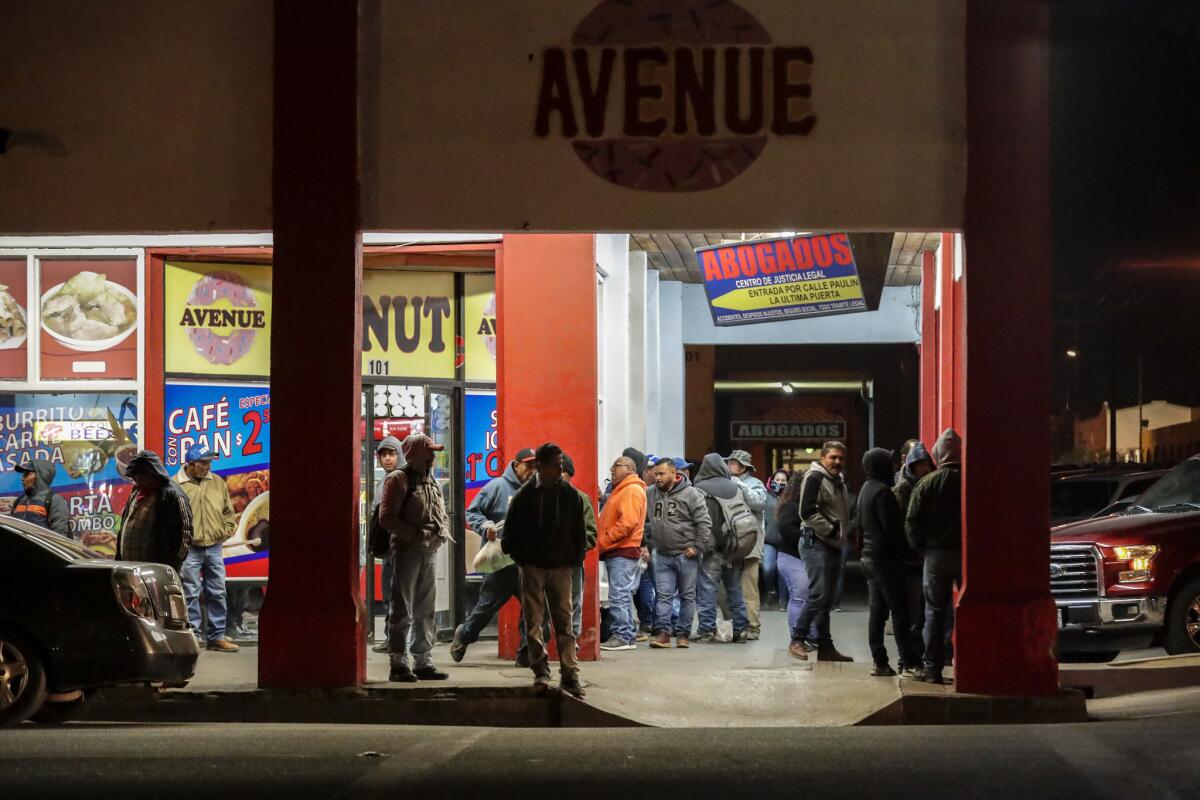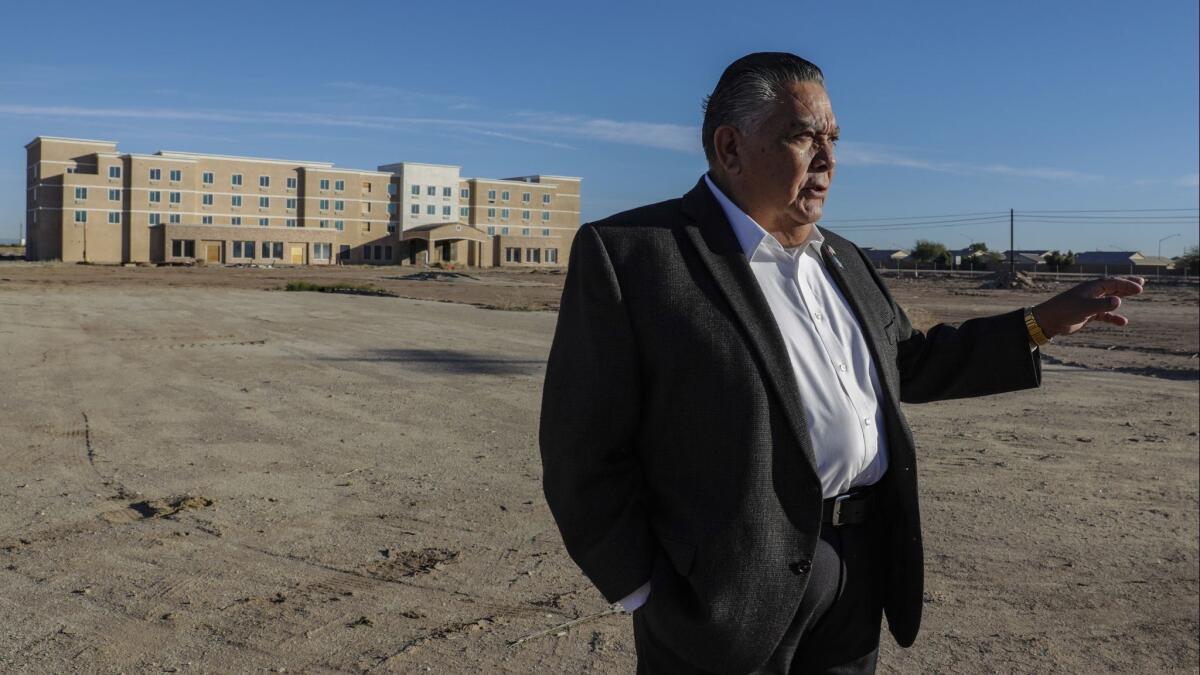This corner of California is suffering economic misery despite boom all around it

- Share via
Parked outside a Calexico job center, Jonathan Lopez leaned against his worn SUV and took a drag from a cigarette. He was waiting, yet again, for word on his unemployment application.
“A well-paying, full-time job is impossible to find,” the 39-year-old lamented as his son played nearby. “I have a family with four children and we struggle. It is a daily battle to make ends meet.”
As California has rebounded from the Great Recession, the Imperial Valley has largely defied attempts to expand its economy beyond seasonal farming and government work, and the county continues to suffer the highest unemployment rates in the state.
According to the U.S. Census Bureau’s latest five-year estimate, Imperial County's unemployment rate stands at 16% — four times greater than the state’s overall jobless rate of 4.2%.
“It’s much better than it was in 2009, when El Centro was mentioned as the highest unemployment in the nation at almost 30%,” county Supervisor Ryan Kelley said. “This is supposed to be the recovery, and every time there is a recovery, we seem to be the least-benefiting area.”
In recent years, locals have pinned hopes of economic salvation on a variety of new industries, such as geothermal energy, lithium extraction and the growing of industrial hemp.
El Centro City Councilman Jason Jackson said the valley — which has “all the things” that should be attractive to industry, like abundant water from the Colorado River and low power rates — is on the cusp of breaking out.
“We’re a little bit isolated,” he said. “We’ve always been thought of as an agricultural community, so industry has never really taken a good, solid look at us.”
Wedged in the southeast corner of the state, between the Mexico border and the Colorado River, the valley has depended heavily on agriculture ever since the Imperial Land Co. helped to bring large-scale irrigation in the early 1900s and transformed a barren desert into abundant farmland.
Although some argue the seasonal nature of farming has inflated county unemployment figures, there is no denying Imperial County is well-acquainted with economic adversity. The median household income is $44,770, well below the state median of $71,805, and nearly a quarter of its residents live below the poverty line. Statewide, that figure is 13.3%.

The vast expanse of flat, sunny land is seen by some renewable energy developers as ideal for solar farms. And the county is home to nearly a dozen geothermal power plants, which use a naturally heated underground reservoir to churn out pollution-free electricity around the clock.
“About five years ago, we saw a sustainable-energy boom, and we thought it would develop the workforce,” said Priscilla Lopez, interim director of the Imperial County Workforce Development Board. “But once built, they didn’t create jobs. You only need five or six people to run those plants.”
Jackson remains optimistic despite such concerns, noting that home builders are coming back to the valley “to look around” for the first time since the housing boom turned into a bust.
“It’s like a dance floor. Nobody wants to be the first couple to go out and dance, but once someone does, everyone goes out,” Jackson said. “I feel like we’re just waiting for that first couple to dance. We haven’t been able to land that one big fish yet.”
Among the crop rows at Jack Vessey's Holtville farm, workers from Mexico harvested bok choy and packaged the vegetables into plastic crates as he greeted his employees. The fourth-generation farmer said he’d been researching other crops as a way to help sustain his business.
“We need those options,” Vessey said. “Plants are going to Mexico. I wouldn’t call it an exodus, but I have to find other crops to grow.”
Industrial hemp, which could be grown twice a year and was approved for cultivation by the federal government in 2018, is a primary candidate, he said.
“Hemp is going to give this valley another high-value crop and possibly another industry through extraction for CBD oils … or making lotions,” he said. “I think a lot of areas in that industry are looking here.”
Key to Imperial County’s economy is its relationship with the border city of Mexicali. More than 50,000 people cross each day, and an estimated $1 billion in consumer retail expenditures come from Mexico annually, according to a 2018 county report.
The county also has welcomed investment from beyond Mexico, under the program known as EB-5. There are three regional centers in Imperial County, approved by U.S. Citizenship and Immigration Services, with the goal of stimulating the local economy through job creation and capital investment by foreign investors. In areas like this with high unemployment rates, investors must put up $500,000 to access the program and receive their own immigration visas.
The program has sparked multiple projects financed by Chinese investors, such as the Town Center Villa apartments in El Centro.
But other ventures have faced difficulties.
Near the intersection of California 86 and Neckel Road in Imperial sits the shell of a Holiday Inn. The project, funded through the investor program, stalled and the building and dirt lot that surrounds it will soon go to auction, county Supervisor Ray Castillo said.
Driving along California 111 in Heber on a recent day, Castillo pulled into a vacant parking lot near a gas station. A Chinese investor broke ground on a project there too, he said, with plans to build a motel and open restaurants that would draw crowds to a new area they would call Imperial Center.
The restaurants opened, then most closed.
At its height, the project employed 150 people, Castillo said. All but 50 lost their jobs. The county seized the center in May as part of a loan default case.
“It’s heartbreaking,” Castillo said. “This started with grand ideas of what we could do.”

Inside an employment center in El Centro last month, crowds of people hunched over computer screens, searching for jobs.
Stephanie Aguilar perused the postings on a job board, which included correctional officer and sales associate at the Gap. She has been looking for work for five months, she said, after being let go from her previous position as a hotel sales manager.
“It’s hard because my parents live in Mexico,” said Aguilar, 27, “and I was helping them pay for my brother’s medical school.”
Angelica Pacheco, a site supervisor for the job center, said some people come in every day to look for work or update their resumes.
“We’ll get hundreds of people applying for one or two openings sometimes,” she said. “It’s hard out there.”
Jonathan Lopez and his wife had left Imperial County several times in hopes of building a better life, but “every time we couldn’t make it out in the big city, we would come back out here to the valley because we have family out here — not because of the job opportunity.”
The family can’t afford to rent an apartment, so they live at Karla’s mom’s house in Heber. They and their four children squeeze into two of the house’s three bedrooms.
“It sucks here,” he said. “The farther you go from the county, the more chances you got.”
His best hope, he thinks, is to earn his air conditioning technician certification while collecting unemployment and looking for work.
After that, he said, the family might move to Arizona to start fresh.

Staff writer Sammy Roth contributed to this report.
Sign up for Essential California
The most important California stories and recommendations in your inbox every morning.
You may occasionally receive promotional content from the Los Angeles Times.








